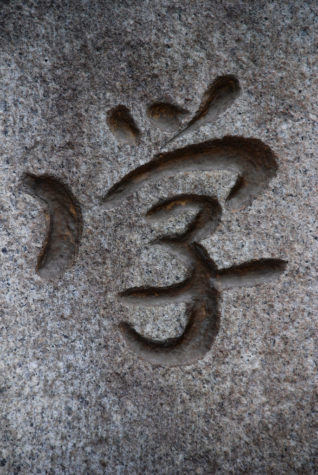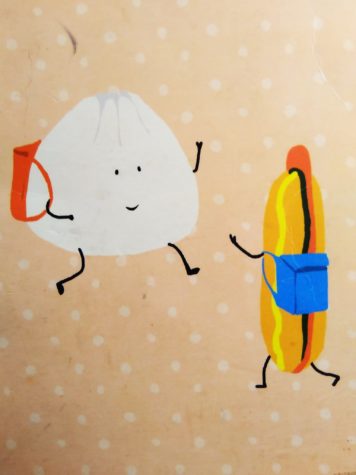This is the first in a series of posts about learning a foreign language long past the age when it comes naturally. Guest Veronique Greenwood begins at the pro level, with Chinese.

I slide into a desk at the back of the dim classroom, and the Thai girl in front of me turns around. What’s your name? I ask. Zern, she chirps. My name is Zern. In the next row over, Maged from Egypt, middle-aged with a wedding ring, leans over to introduce himself, too. He asks, have you studied Chinese before?
For me it’s a bit of a trick question. Years ago I listened to six months’ worth of Mandarin learning podcasts, with my husband, a literary translator, hammering the correct pronunciations into my head. But now that we’ve moved to China, those fragments aren’t anywhere close to enough. A girl to the left of me types like mad in Chinese on her phone. I hesitate—I can’t read even a single Chinese character, just pinyin, the pronunciation guide written in roman letters. Can this really be the right class level?
If I were able to speak clearly to these people, here is how I would describe my language ability: I am like a Jewish thirteen-year-old about to have her bat mitzvah, one who doesn’t really speak Hebrew but can pronounce words on the page perfectly. Also, sometimes, thanks to those long-ago lessons, I am like a parrot. When my husband and I are quietly sitting on the couch, I turn to him and speak sounds that rise unbidden to my lips: “Siblings? What country? You’re welcome.” Then I lean in closer and ask, What did I just say?
To Zern, I mumble something about knowing a little. As other people filter in I feel a flutter of anxiety. In the placement exam I took three days ago, I stared into the middle distance while the words washed over me. At the end of a flood of sound, a voice would say quietly, What does the woman want? Another gush of words–I could pick out rice, mountain, car, hotel–and then: What does the man want? I marked nothing on the answer sheet.
The teacher walks in, and turns on the lights. Why were you sitting in the dark? she says. At least I think she says that–the tone is fairly clear, but none of those are words I currently have hanging around in my head. She walks to the front of the class, takes out her notes, and the sea of words rises, submerging me. I open my eyes wider and lean in.
—
Day three of classes.
“Good Morning,” says the cover of my notebook. Then, in smaller letters: “No matter how good or bad you think life is, wake up each day and be thankful for life.” A jaunty pork bun wearing a backpack waves at a passing hot dog, also equipped with a school bag. The message of this intercultural meeting is clear; study hard, even if you might be eaten at any moment.
The Chinese method of language teaching involves copious repetition, and the teacher strides around the class holding the book in her hand, shouting the words. “You!” “You!” we roar. “They!” she cries. “They!” we holler. The list of words in our book is written in the spidery characters—totally mysterious to me still. Next to it is the pinyin, at first glance looking like English or Spanish.
Pinyin bears explaining. Since written Chinese isn’t phonetic—unlike the letters of an alphabet—there’s no way for a beginner to pick up what a word will sound like from its character. As a crutch, foreign learners of Chinese have long used Roman script to put the sounds of characters on the page. In 1605, Matteo Ricci, a Jesuit missionary in Beijing, published a book called The Miracle of Western Letters that included the first-known romanization system.

Many systems followed, all trying to render Mandarin on the page so it could be sounded out, trying to capture the buzzing and sighing of the spoken language and puzzling over how to handle the tones. The stories of these systems—the one Soviet scientists developed in the 1920s so uneducated Chinese in Siberia could become literate, the one a Yale sinologist created to prepare American soldiers for Asian battlefields in 1943, the one that tricked westerners into thinking that martial art is called kung fu (it’s really “gong fu”)—would fill a book.
Pinyin was invented by a group led by a Chinese banker at the beginning of the Communist Era, and the system happens to be the one that’s been in use since the 1950s in China and since the 1970s in the rest of the world. It’s helpful, but it’s not something you can just read right off the page without extra training: Pinyin’s roman letters often stand for different sounds than an English-speaker would expect. “Shui” is said “shwei.” The letter “c” indicates a “ts” sound. The “z” means putting one’s tongue against the back of the front teeth and buzzing gently: “dzzz.” And of course the tones for each syllable are indicated by little lines rising and falling above the vowels.
—
Regarding tones—those mysterious noises that so frighten and frustrate new learners–it is a myth that English does not have them.
The “yes?” of a secretary looking up to see someone standing at her desk—its rising contour is what’s called second tone. The “no” of a sullen child replying to a parent asking whether they should really be doing that—that dip, so low in the middle that their voice cracks a little, is third tone. The “hey!” of someone who’s just discovered a neighbor’s dog popping a squat on their lawn—that short, sharp fall is fourth tone. First tone is slightly harder to find, but the “oh” in “oh no!,” high and flat, is just the same sound, and the fall of the the “no!” is fourth. “Oh no!” has the same tonal shape as the phrase “to eat” in Mandarin.
Now imagine that instead of encoding meaning about your emotional state or your expectations—and in English, that’s exactly what tones do—they are as much as part of the word as the consonants and vowels. Mandarin and English both exploit this natural variation in how humans make noise; Mandarin just assigns far more specificity to it.
Depending on the tone, a syllable like “bao” can mean a package, to be thin, to be full, and to explode; “bing” can mean ice or a fried cake—or even more, depending on context. The fact that those words use the same syllable with different tones is not something people think of consciously most of the the time. Chinese kids don’t even really know about tones until they’re learning to read pinyin in elementary school, according to my language partner, a 22-year-old Hunanese girl who teaches me basic phrases in return for English conversation and Chinese celebrity gossip. It’s the same way that French kids don’t think of the gender of words as being separate.
This does mean that the moment someone’s tones become unclear, their words’ meanings can evaporate. There are simply too many possibilities for those syllables, standing apart from their sound contours. It’s not as common as you might think to say the wrong tone and accidentally make sense. Often, in the course of a single sentence, I’ll watch a classmate go from speaking like a normal person to making nonsense sounds that have even the teacher squinting.
—
Several weeks in, and it’s not getting any easier. Learning Chinese, I’m realizing, is like trying to build a boat that you need to sail across the ocean with tools you just picked up for the first time. There’s this weird chicken-egg conundrum: You want to speak, but you MUST learn to read and write…so that you can understand how to speak. Knowing the pinyin, unfortunately, is not enough. So many words look just the same in pinyin–there are so many homophones–that knowing the character is required. It’s how you understand what the sound you want to make means.
I flail onward in boat-building, poking my jigsaw into a sheet of plywood and gesticulating until I get something like a rudder. It’s not the most graceful metaphor–but it’s the least graceful process I can imagine.
I fill notebook pages with characters whose meaning I can’t quite recall. I stare at sentences in class not quite remembering the characters’ sounds. When I have the sounds in mind, I can’t reach the characters anymore, even though I usually find the meaning within grasping distance. Nothing is ever all in the same place at the same time. But we barrel onward, me and my fifteen foreign friends—almost every one a different nationality, from Congolese to Colombian—and this young Chinese woman who clearly thinks we are adorable.
“So cute!” she says, and teaches us how to say it in Chinese. Like deranged toddlers, we babble her speech back at her, eagerly, helplessly. She laughs so hard she has to put her hands on her knees.
______
Next up next Monday: Shop Owner! Bring Me a Sheet of Table!
And the Monday after that: All the Chinese You Need to Take a Shower
Veronique Greenwood is a science writer and essayist whose work has appeared in The New York Times Magazine, Aeon, Discover, Popular Science, and many others. You can follow her on Twitter at @vero_greenwood.
Thanks for this post! I love your descriptions of the frustrations and indignities involved. 🙂 And I’m going to steal your English examples of the tones, if you don’t mind.
@Peter, hah, yes, the frustrations and indignities are many! But you just kind of have to put your shame in a box and leave it at the door, and try not to think about how you sound. Glad you enjoyed the description of the tones!
A beautiful piece indeed. As a native Chinese boy I learned ‘putonghua’ (ie, Mandarin in China today) completely from learning the spoken words and the written characters, without any idea there was such a thing as ‘pinyin’! Even living in a British colony.
@Kaiyng Chan, yes, I believe pinyin’s only recently come into the toolkit when it comes to teaching native speakers to read. Do you speak Cantonese too?